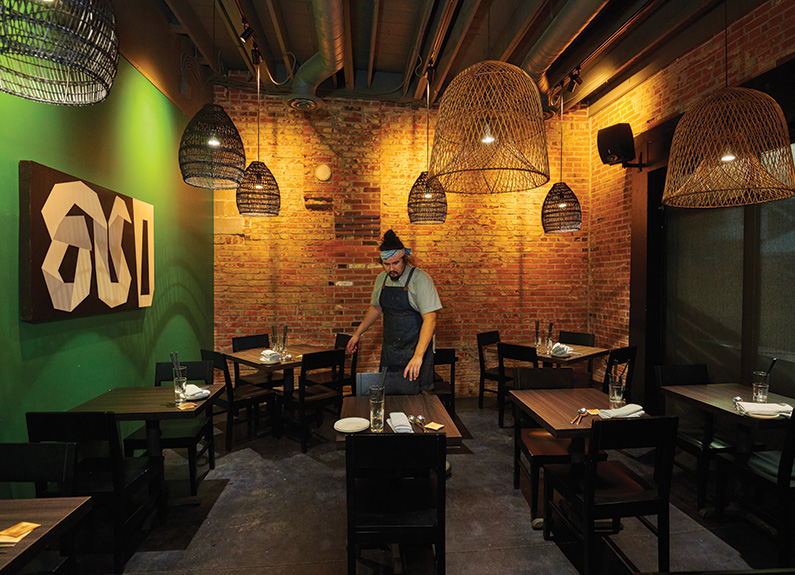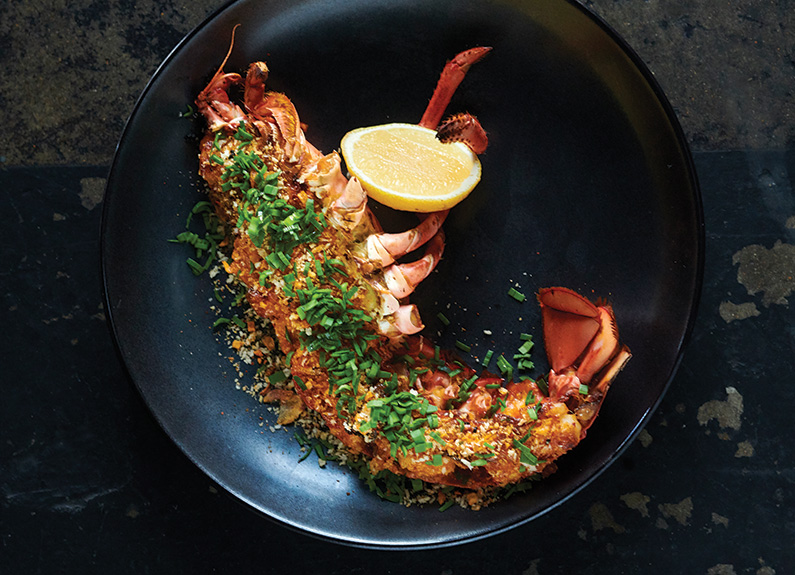2019 Best New Restaurants // No. 1 Indo
Nick Bognar isn’t afraid to tell you what he’s good at. He knows he’s a good cook. As a young chef, he moved across the country to work under the best chefs he could find, learning how to do what they did – or better. The food was the only thing that mattered.
“But the restaurant is far more complicated than that,” he said. Running a restaurant is about being a good manager – it’s about creating a vision people can believe in, convincing them to trust you. “And now I’m good at it, so everybody’s just stoked.”

He’s right. Staff, diners and critics all seem pretty stoked about Indo, Bognar’s 46-seat, modern Asian restaurant in Botanical Heights. They come in for pricy sushi and small plate dinners, a casual khao soi off the unique lunch menu and the perpetually sold-out omakase (chef’s choice) tasting menu served only Tuesday, Wednesday and Thursday nights.
Looking at the menu, it can be hard to classify Indo. There are old-school Thai flavors like the unctuous, shareable short rib red curry. The nam prik chili paste, a condiment in dishes like a koji-aged rib-eye, is straight-up Bognar’s Thai grandmother’s recipe.
“I basically am successful by building on top of what my family R&D-ed for years,” he said. But that rib-eye, while delicious, definitely isn’t a family dish. There’s a lobster thermidor special, a Peruvian-style madai ceviche, a dessert of Indian roti (buttery flatbread) paired with Latin American dulce de leche. And what do any of these have to do with the high-end sashimi menu?

The Isaan hamachi – arguably Indo’s signature dish – is a good cipher for understanding the restaurant’s genius. The dish begins with hamachi (yellowtail), which is salted to pull out water and improve the texture of the fish, then sliced into proper sashimi. Next come the coconut naam pla (a sauce made with chili, garlic, fish sauce, fish caramel, coconut milk and a lot of lime), roasted chili oil, Thai kosho (a paste of Thai chilies, Thai basil, lime, palm syrup and fermented fish paste), candied garlic and more fish sauce.
“Yeah, it is a lot of things,” Bognar said. “That’s why it’s good, though. Balancing those things is essentially Thai food in a nutshell, right? Japanese food is very subtle, and Thai food is very in your face. So, it’s kind of an odd marriage, but it works. I think it’s good.”
The hamachi is a testament to the simple perfection of expert Japanese technique Bognar learned while working at Uchiko in Austin. It’s what got him named a James Beard Rising Star Chef of the Year semifinalist after he took over his family’s restaurant, Nippon Tei, in Ballwin.
But the sauce – an astonishing Thai composition of savory funk, rich sweetness, sour citrus, complex spice, bright herbal notes and blurring coconut, which unites the flavors like a blending stump – the sauce is Bognar cooking what he wants.

“It’s really been about cooking the food that I naturally crave,” Bognar said. “Like, going back to older flavors that my family used to make all the time. I love creating these deeper, Southeast Asian flavors – making curry pastes from old-school grandma recipes and using them in interesting ways.”
Indo sources some of the highest quality seafood available in St. Louis, product that can be served barely touched, but it also creates value by taking low-cost ingredients and turning them into magic.
“That’s why the restaurant is good,” Bognar said. “I’m not gonna make Thai kosho at home because I know what it entails. But at the restaurant, I have the equipment, and I have all day. So that’s what really brings value to the food.”
This juggling of the simple with the bold, the elegant with the aggressive, is the red thread tying Indo together. It is both a fine dining destination and a casual neighborhood spot. Dinner expenses can climb high into the triple digits, but the plating isn’t fussy and the service even less so. The coursing is frenetic. A simple pile of cabbage in tamarind dressing is followed by a flurry of spicy salmon hand rolls propped in shot glasses like bouquets.

Anticipation mounts as the dice roll, but each plate thrills with a win – the letdown never comes. The spare decor is invigorated by a vibey, beat-laden soundtrack of artists like Solange and Sza. The chairs are not comfortable; no one cares. Everyone is having a great time.
That includes the young, diverse kitchen staff, who come in every day starting at 9 a.m. to make everything from the labor-intensive Thai curry pastes down to the chili oil and palm syrup. They execute at the same level when Bognar’s running the kitchen and when he’s in New York on a press tour. They’re having fun too. It’s a quality that resonates.
“You just gotta make it fun, dude,” Bognar said. “That’s everything. It’s a restaurant – it’s meant to be a party.”
Heather Hughes Huff is managing editor at Sauce Magazine.
Tags : Places, Restaurants, Best New Restaurants






